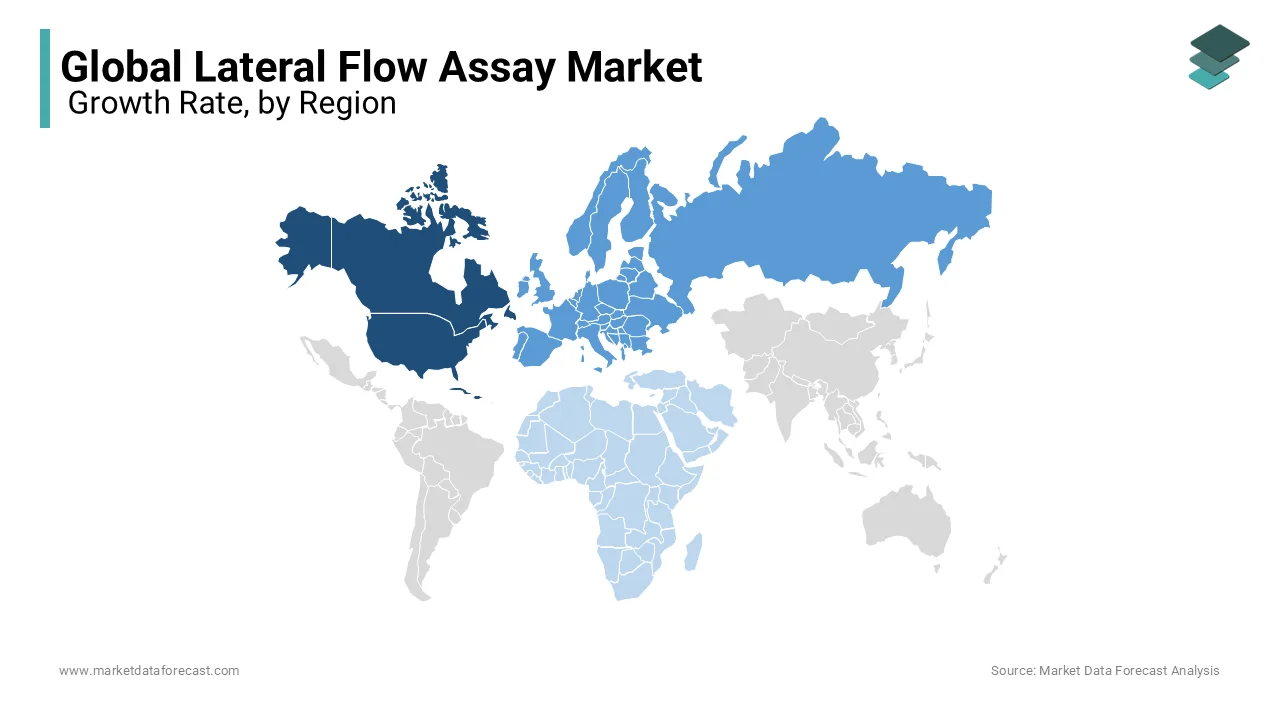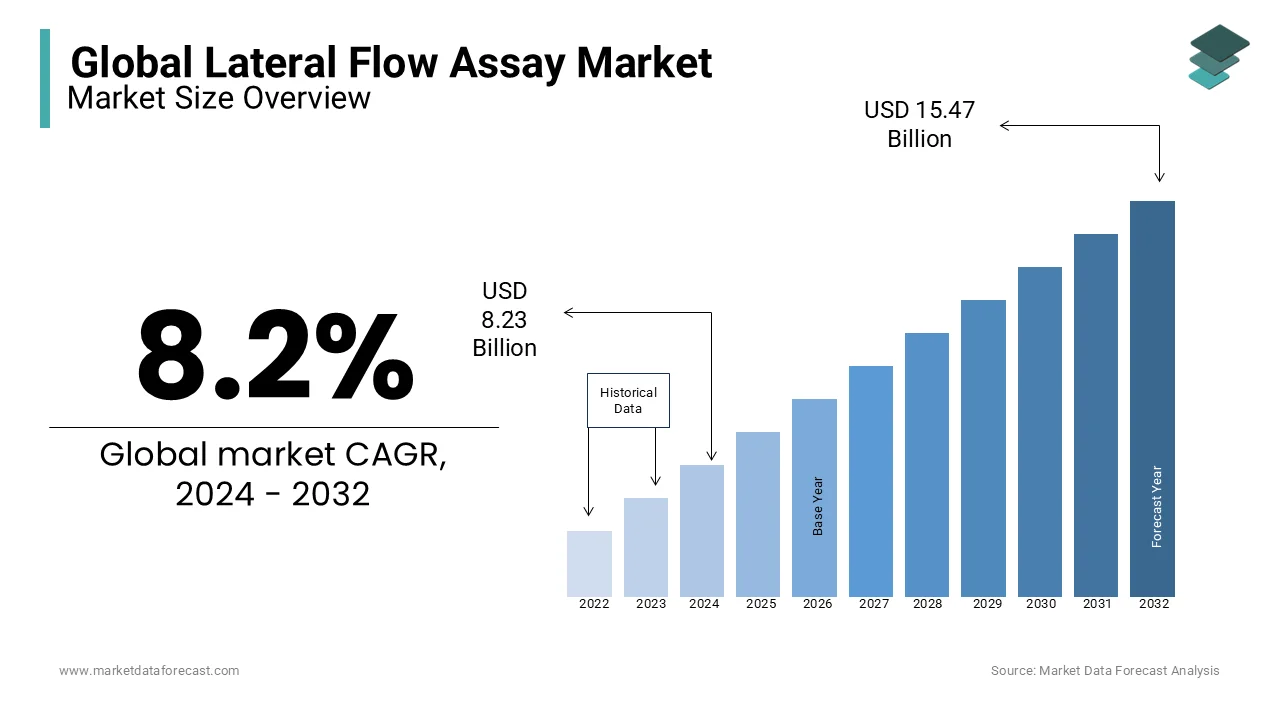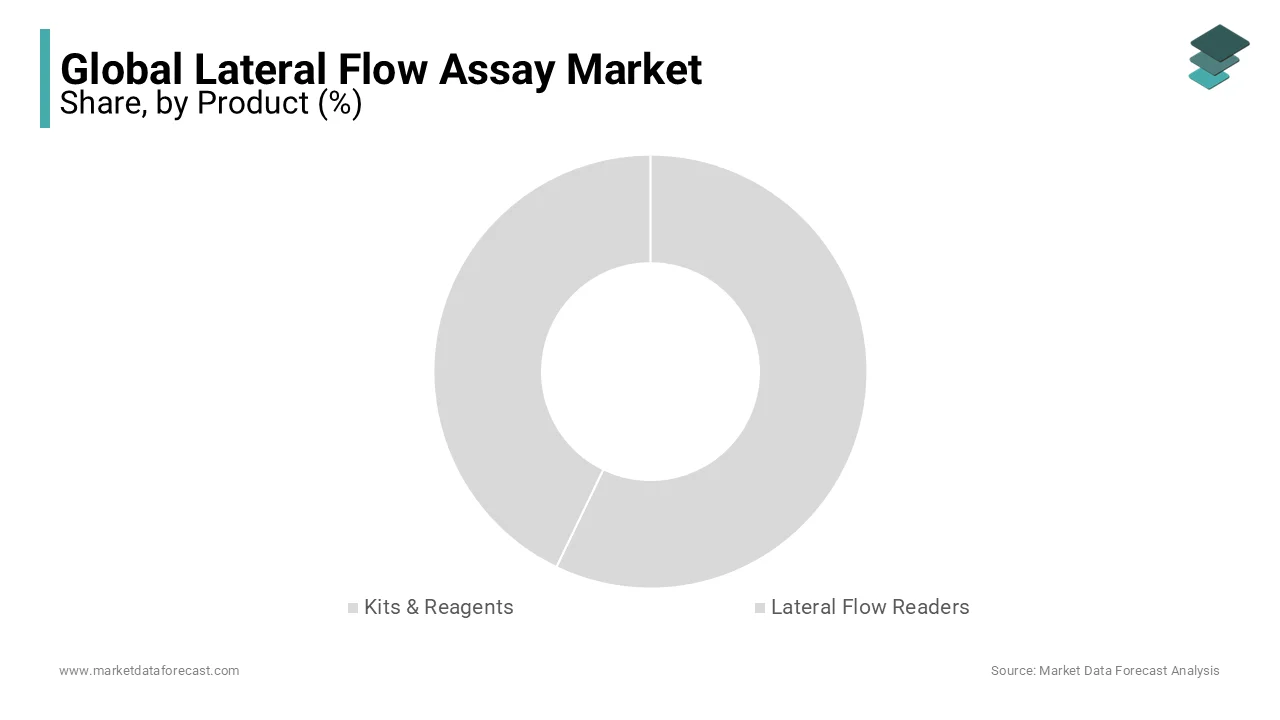Global Lateral Flow Assay Market Size, Share, Trends & Growth Forecast Report By Product (Kits & Reagents and Lateral Flow Readers), Technique (Sandwich Assays, Competitive Assays and Multiplex Detection Assays), Application, End-User (Hospitals and Clinics, Home Care, Diagnostic Laboratories, Pharmaceutical and Biotechnology Companies) and Region (North America, Europe, Asia Pacific, Latin America, and Middle East & Africa), Industry Analysis From 2025 to 2033
Global Lateral Flow Assay Market Size
The global lateral flow assay market size was valued at USD 8.23 billion in 2024 and is anticipated to grow at an 8.2% CAGR from 2025 to 2033. It is estimated that the worldwide market is predicted to value USD 8.90 billion in 2025 and USD 16.72 billion by 2033.
MARKET DRIVERS
Growing Demand for Pint-of-Care Testing
Lateral flow assays require only a small number of biological samples to produce results, and due to this, they are increasingly being used in point-of-care testing. Point-of-care testing has been rapidly growing over the last several years as it is simple to use and cost-effective, and it provides quick and accurate results to patients without requiring access to expensive laboratory equipment. Currently, point-of-care testing is increasingly used to diagnose infectious diseases, as well as pregnancy testing and drug testing. Considering the simplicity, speed, and cost-effectiveness of lateral flow assays, these are widely used in point-of-care testing. In the coming years, the demand for lateral flow assays in point-of-care testing is expected to fuel and drive market growth.
Rising Prevalence of Infectious Diseases
Lateral flow assays are rapid and cost-effective diagnostic tests and an effective solution to detect the presence of various agents of infectious diseases in biological samples and are believed to be a vital tool in the diagnosis and monitoring of infectious diseases. In recent days, COVID-19 has significantly boosted the demand for lateral flow assays for the detection of the SARS-CoV-2 virus. During the COVID-19 pandemic, the tests have been increasingly used in various workplaces, including airports, schools, and homes.
Technological advancements in Lateral Flow Assays
Due to technological advancements, the development of more accurate diagnostic tests made them possible, and due to this, their adoption has grown in the healthcare industry. The growing usage of lateral flow assays in the food industry to detect pathogens and toxins in food products due to the growing concerns about food safety boosts the growth rate of the market. The rising demand for home-based testing due to their ease of use and simplicity, increasing usage of lateral flow assays in veterinary diagnostics primarily for the detection of infectious diseases in animals, rising usage of lateral flow assays in the drug development and rapidly expanding biotechnology industry favor the market growth. Furthermore, the growing adoption of personalized medicine and the increasing aging population worldwide promote market growth.
MARKET RESTRAINTS
Limitations in sensitivity and specificity and the competition from alternative testing methods such as ELISA, PCR, and next-generation sequencing majorly hamper the market growth. Lack of standardization, stringent regulatory environment for lateral flow assays, technological limitations and quality control issues further hinder the market growth. Reluctance from healthcare professionals to shift from established diagnostic methods and the introduction of multiplexed assays inhibit the growth rate of the market.
REPORT COVERAGE
|
REPORT METRIC |
DETAILS |
|
Market Size Available |
2024 to 2033 |
|
Base Year |
2024 |
|
Forecast Period |
2025 to 2033 |
|
Segments Covered |
By Product, Technique, Application, End-User, and Region |
|
Various Analyses Covered |
Global, Regional & Country Level Analysis, Segment-Level Analysis; DROC, PESTLE Analysis, Porter's Five Forces Analysis, Competitive Landscape, Analyst Overview of Investment Opportunities |
|
Regions Covered |
North America, Europe, APAC, Latin America, Middle East & Africa |
|
Market Leader Profiled |
Alere Inc., F. Hoffmann-La Roche AG, Danaher Corporation, Siemens AG, Becton, Dickinson and Company, bioMérieux SA, Johnson & Johnson, Bio-Rad Laboratories Inc., Thermo Fisher Scientific Inc., QIAGEN N.V., and PerkinElmer Inc. |
SEGMENTAL ANALYSIS
By Product Insights
The kits segment held the largest share in the global lateral flow assay market in 2024 and the domination is likely to continue throughout the forecast period owing to the rising use of kits and reagents for the detection of various diseases such as infectious diseases, cancer, and pregnancy. The growing prevalence of chronic diseases, increasing demand for rapid and point-of-care testing, the rising adoption of lateral flow assays in home care settings and the development of user-friendly and cost-effective kits fuel the growth rate of the segment.
On the other hand, the lateral flow readers segment is expected to grow at a notable CAGR during the forecast period. Under the sub-segments, the digital/mobile readers segment is anticipated to witness a better CAGR than the benchtop readers segment in the coming years due to the rising demand for portable and easy-to-use diagnostic devices. The integration of smartphones with lateral flow readers and the development of mobile applications for diagnostic testing is another key factor fuelling the growth rate of the segment.
By Technique Insights
The sandwich assays segment occupied the major share of the worldwide lateral flow assay market in 2024, and the domination of the segment is likely to continue during the forecast period. The growing patient population suffering from chronic and infectious diseases, the rising demand for point-of-care testing, the development of highly specific and sensitive sandwich assays and the increasing adoption of multiplexed assays drive the segmental growth.
The multiplex detection assay segment is estimated to witness the fastest CAGR in the coming years. Factors such as the rising demand for high-throughput diagnostic tests, the growing adoption of multiplex detection assays in research and diagnostic laboratories and the development of highly sensitive and specific multiplex detection assays primarily boost the growth rate of the segment.
The competitive assays segment is anticipated to showcase a healthy CAGR during the forecast period due to the rising adoption of competitive assays for the detection of drugs, hormones, and other small molecules, the development of highly sensitive and specific competitive assays and the increasing application of competitive assays in food safety and environmental testing primarily boost the growth rate of the segment.
By Application Insights
The clinical testing segment accounted for a significant share of the global lateral flow assay market in 2024. The growing patient population suffering from chronic and infectious diseases, increasing demand for rapid and point-of-care testing, the development of user-friendly and cost-effective lateral flow assays, the increasing adoption of lateral flow assays in home care settings and the development of smartphone-based lateral flow assays are some of the major factors driving the segmental growth.
The veterinary diagnostics segment is predicted to witness a promising CAGR during the forecast period. The segmental growth is majorly driven by the rising adoption of lateral flow assays in veterinary clinics and the development of specific and sensitive lateral flow assays for animal diseases.
The food safety and environment testing segment is expected to grow at a notable CAGR in the coming years. Factors such as the growing adoption of lateral flow assays in food safety and environmental testing, the development of specific and sensitive lateral flow assays, and rising demand for rapid and cost-effective diagnostic tests primarily drive segmental growth.
The drug development and quality testing segment is another noteworthy segment among all and is estimated to grow at a healthy CAGR in the coming years. The growing demand for rapid and accurate diagnostic tests in pharmaceutical and biotechnology industries, increasing adoption of lateral flow assays in drug development and quality testing, the development of highly specific and sensitive lateral flow assays, and the growing demand for cost-effective and high-throughput diagnostic tests majorly promote the segmental growth.
By End User Insights
The hospitals and clinics segment had the largest share of the global market in 2024 and is expected to grow at a promising CAGR during the forecast period. The segmental growth is majorly driven by the growing prevalence of chronic and infectious diseases, the growing demand for rapid and point-of-care testing, and the development of user-friendly and cost-effective lateral flow assays.
The pharmaceutical segment is another noteworthy segment and is expected to grow at a prominent CAGR during the forecast period owing to the growing demand for rapid and accurate diagnostic tests in drug development and quality testing, the rising adoption of lateral flow assays in drug development and quality testing, the development of highly specific and sensitive lateral flow assays, and the growing demand for cost-effective and high-throughput diagnostic tests.
The home care segment is anticipated to grow at a promising CAGR during the forecast period. Factors such as the rising demand for self-monitoring and rapid diagnostic tests and the development of smartphone-based lateral flow assays.
REGIONAL ANALYSIS
North America held the largest share of the global market in 2023 and predicted the same would repeat throughout the forecast period. The rising adoption of point-of-care testing, the presence of well-established healthcare infrastructure, and the increasing prevalence of chronic and infectious diseases primarily fuel the growth rate of the North American market. The rising demand for rapid and accurate diagnostic tests, the development of highly specific and sensitive lateral flow assays, the growing healthcare expenditure, favorable reimbursement policies for lateral flow assays in the U.S., and the rising adoption of digital/mobile lateral flow readers in Canada further boost the growth rate of the North American market. The rising trend of home healthcare and self-testing and the growing demand for personalized medicine in the U.S. contribute to regional market growth. The U.S. held the major share of the North American market in 2024, followed by Canada.

Europe accounted for a substantial share of the global market in 2023 and is predicted to grow at a healthy CAGR during the forecast period. The growth of the European lateral flow assay market is primarily driven by the rising adoption of lateral flow assays in various applications, increasing usage of lateral flow assays for the diagnosis of infectious diseases, cancer, and cardiovascular diseases in Europe, growing prevalence of chronic and infectious diseases, the development of highly specific and sensitive lateral flow assays, and the growing demand for cost-effective and high-throughput diagnostic tests. Furthermore, strict regulatory requirements for diagnostic tests in the European Union, the rising prevalence of lifestyle-related diseases such as obesity and diabetes in Western Europe, the growing demand for lateral flow assays for food safety testing in Europe and an increasing number of research collaborations and partnerships in Europe primarily drive the European market growth. The UK captured the leading share of the European market in 2023 and is expected to grow at a healthy CAGR during the forecast period. Factors include the rising demand for lateral flow assays for food safety testing and the increasing number of research collaborations and partnerships.
APAC is forecasted to register the highest CAGR among all the regions in the worldwide market during the forecast period. Factors such as the growing prevalence of chronic and infectious diseases, the growing demand for rapid and accurate diagnostic tests, and the development of user-friendly and cost-effective lateral flow assays, the large population base and the high burden of infectious diseases in countries like India and China majorly drive the growth of the APAC lateral flow assay market. In addition, rising healthcare expenditure and government initiatives for healthcare reforms in the region, increasing demand for lateral flow assays for environmental monitoring in the Asia Pacific, and rising number of mergers and acquisitions in the region further boost the growth rate of the APAC market. China, followed by Japan, accounted for the leading share of the APAC market in 2023.
Latin America occupied a considerable share of the worldwide market in 2023 and is expected to grow at a healthy CAGR during the forecast period. The growth of the Latin American lateral flow assay market is driven by the rising prevalence of neglected tropical diseases in Latin America, the rising adoption of lateral flow assays for drug testing and development in Brazil, increasing public-private partnerships for healthcare infrastructure development in the region and rising emphasis on sustainable development and environmental monitoring in the region.
The lateral flow assay market in MEA is anticipated to showcase a moderate CAGR in the coming years owing to the rising burden of infectious diseases such as HIV/AIDS and tuberculosis in Africa and rising demand for lateral flow assays for oil and gas industry applications in the Middle East.
KEY MARKET PLAYERS
Noteworthy companies dominating the global lateral flow assay market profiled in this report are Alere Inc., F. Hoffmann-La Roche AG, Danaher Corporation, Siemens AG, Becton, Dickinson and Company, bioMérieux SA, Johnson & Johnson, Bio-Rad Laboratories Inc., Thermo Fisher Scientific Inc., QIAGEN N.V., and PerkinElmer Inc.
RECENT HAPPENINGS IN THE GLOBAL MARKET
- In July 2020, Abbott Laboratories launched a COVID-19 antigen test kit.
- In April 2020, Siemens Healthineers AG launched a Coronavirus COVID-19 test kit.
- In July 2020, Becton, Dickinson, and Company unveiled an antigen test kit for SARS-CoV-2 detection.
- In March 2020, Becton, Dickinson, and Company launched a fast serology test to detect COVID-19 exposure and a SARS-CoV-2 real-time PCR detection kit.
- In September 2020, An Access Anti-SARS-CoV-2 Test kit was released by QIAGEN N.V.
MARKET SEGMENTATION
This market research report on the global lateral flow assay market has been segmented and sub-segmented based on the product, technique, application, end-user, and region.
By Product
- Kits & Reagents
- Lateral Flow Readers
- Digital/Mobile Readers
- Benchtop Readers
By Technique
- Sandwich Assays
- Competitive Assays
- Multiplex Detection Assays
By Application
- Clinical/Point-of-Care Testing
- Infectious Disease Testing
- Mosquito-Borne Disease Testing
- Influenza Testing
- Sexually Transmitted Infections
- Hepatitis
- Tuberculosis
- Other Infectious Diseases
- Cardiac Marker Testing
- Pregnancy & Fertility Testing
- Pregnancy Testing
- Fertility Testing
- Cholesterol/Lipid Testing
- Drugs-of-Abuse Testing
- Other Tests
- Infectious Disease Testing
- Veterinary Diagnostics
- Food Safety & Environment Testing
- Drug Development & Quality Testing
- Other Applications
By End User
- Hospitals and Clinics
- Home Care
- Diagnostic Laboratories
- Pharmaceutical
- Biotechnology Companies
By Region
- North America
- Europe
- Asia Pacific
- Latin America
- Middle East and Africa
Frequently Asked Questions
How much is the global lateral flow assay market going to be worth by 2033?
The global lateral flow assay market size is predicted to be worth USD 16.72 billion by 2033.
What is the growth rate of the global lateral flow assay market?
The global lateral flow assay market is currently growing at a healthy pace and is expected to showcase a CAGR of 8.2% from 2025 to 2033.
Which region had the highest share in the global lateral flow assay market in 2024?
The North American region dominated and accounted for the largest share of the global lateral flow assay market in 2024.
Which are the significant players operating in the lateral flow assay market?
Alere Inc., F. Hoffmann-La Roche AG, Danaher Corporation, Siemens AG, Becton, Dickinson and Company, bioMérieux SA, Johnson & Johnson, Bio-Rad Laboratories Inc., Thermo Fisher Scientific Inc., QIAGEN N.V., and PerkinElmer Inc. are a few of the noteworthy players in the global lateral flow assay market.
Related Reports
Access the study in MULTIPLE FORMATS
Purchase options starting from $ 2500
Didn’t find what you’re looking for?
TALK TO OUR ANALYST TEAM
Need something within your budget?
NO WORRIES! WE GOT YOU COVERED!
Call us on: +1 888 702 9696 (U.S Toll Free)
Write to us: [email protected]


